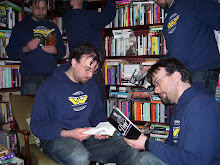The cover is another example of effective use of black and white. It's by Natasha Michaels, about whom I can discover very little. Design week notes that "Random House's in-house team has come up with this bold cover design for ... a book about ancient werewolves living in modern-day Los Angeles. Natasha Michaels created the stark cover artwork, which continues within the pages, where free verse is peppered with haunting canine images created by Suzanne Dean."

I also wanted to talk about another cover artist who works extremely effectively in black and white. This is Russian-born, UK-based Vania (or Ivan) Zouravliov, who did the beautiful cover for Vintage's Grimm's Fairy Tales discussed in an earlier post. However, two things are stopping me. First of all, his website has died, so it's quite hard to get more information on him. Secondly, much of what I can find of his seems to be illustrative work for sleazy porn. This is simply too depressing for words. That someone with such skill and talent should have spent so much time doing beautifully detailed work for a bunch of knob-polishers seems an incredible waste.
Anyway, here are a couple of his good things. The first is a cover image for a collection of stories and poems for Poe (in both its more effective monochrome version, and the final colourised cover), and the second is from I know not what.






2 comments:
fabulous use of black and white, Arthur Rackham on steroids so to speak. It makes you wonder, had he been born in the UK would such a precocious talent have been allowed to develop in this manner. I remember when I was at art college (a long time ago now) any leanings towards tight, traditional work were stomped on heavily by the faculty.
A good illustrator friend from Russia told me how the Soviet Union subsidised art education and publishing, encouraging tight technical prowess, but the entire edifice has crumbled since then, Russian publishing is on it's knees, artists have fled the country to work in Europe, the US and UK (like Zouravliov). My friend is an astonishing graphic artist, now lives in Paris, has given up illustration completely and focuses entirely on art installations.
Yes, I really think that illustration--as opposed to photo manipulation--is almost in danger of becoming a lost art. Some of the stuff that's being done by Zouravliov and co is truly amazing, but most of it remains unseen. Having said that, though, some of the most skilled illustrators are showcasing their work in blogs.
And having spent some happy time stumbling around your site (love your work!), I can only agree with your "manifesto" (if you'll let me call it that) about good commercial illustration combining the "graphic punch", the creation of a visual world, and capturing character. Great stuff. Thanks!
Post a Comment